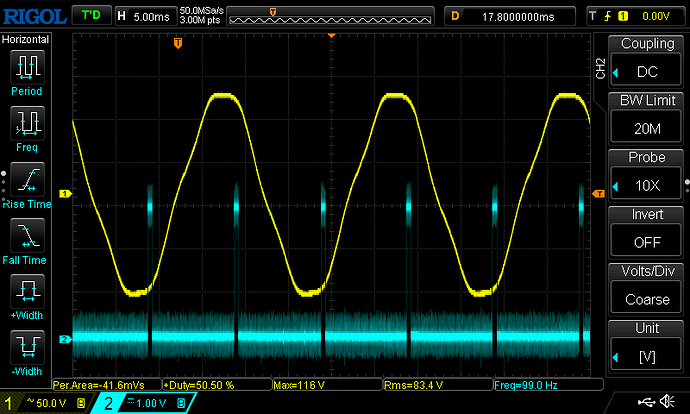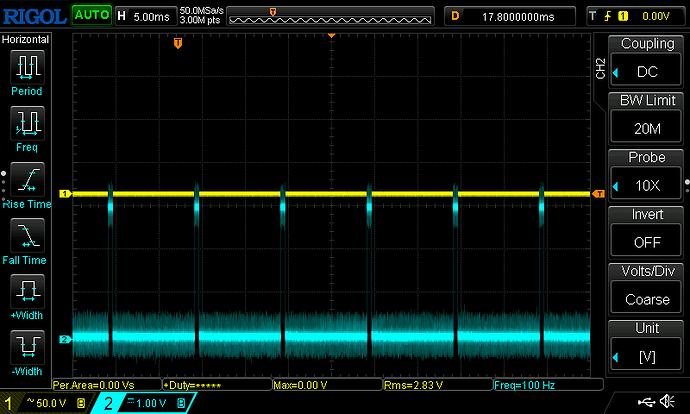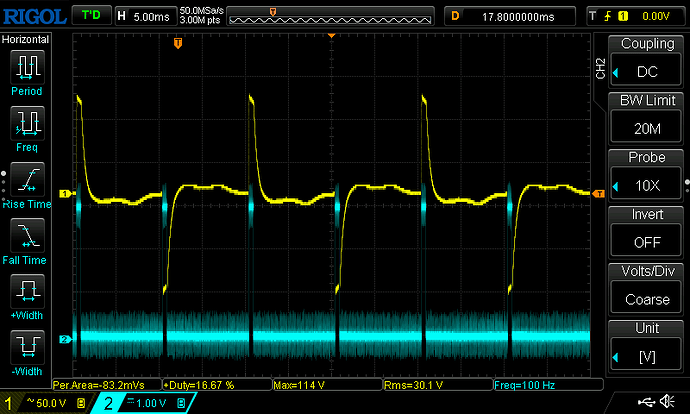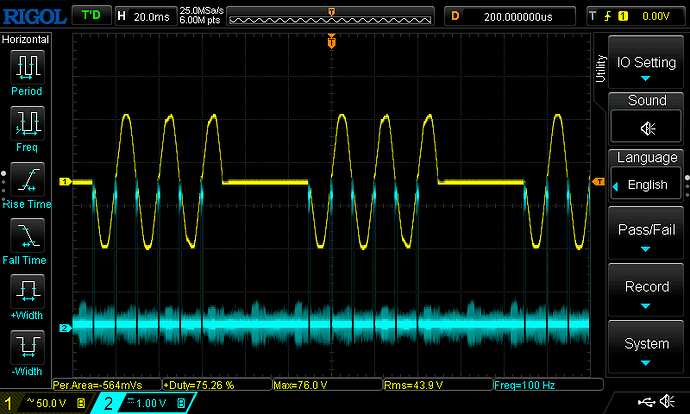I have a tri phase installation without neutral and trying to make a circuit for power diversion to 3kw mono phase hot water boiler. Schematic is the same as on this site with zero cross detection and esp8266. Everything tests ok with isolated low ac voltage without load. When connected to mains and with 40w light bulb however, bulb just flickers uncontrollably. No idea where to look at next. Having no neutral shouldn’t matter as it’s 230v between any two wires.
With your 3-wire system, you can treat (for the purposes of understanding - NOT for safety) any two wires as line and neutral.
My immediate thought is your triac isn’t latching. When it’s hit by the gate pulse and starts conducting, it needs a minimum current to latch and if you haven’t got that, it won’t remain conducting for the rest of the half-cycle. You need a higher powered load or a triac with a lower latching current to get the desired behaviour. A snubber will also help.
Judging by the power draw, it seems to be the opposite - it’s not turning off properly, so it stays on even after wave crosses zero. There is no inductance in the load, and in latest test setup I used a resistive 2.5kW heater submerged in the bucket of water (pool heater). On the scope, it looks good without load, but can’t really test with load attached and board powered with 230V since I don’t have insulation transformer. Zero cross detection seems ok, and triac turns on after a delay proportional to (10ms-power). I tried with both BTA41 and BTA26, same issue. I am using MOC3043 with zero detection circuit.
I can only know what you write here about your system, so I knew nothing about power draw.
Is it possible that the I.R. LED is not turning off properly?
Have you got good isolation underneath and around the MOC3043?
Are you using this: Diverting surplus PV Power, by Robin Emley — OpenEnergyMonitor 0.0.1 documentation circuit arrangement and values?
I tried a variety of resistor values, now I left it with the values from the url you posted. 180 ohm input resistor, and 360/330 for triac. No snubber circuit. With snubber installed, it does not turn off on zero crossing without the load. Without snubber, tested with 60VAC isolation transformer and no load, all seems good on the scope. I guess I can still test with snubber and full 2.5kW load on 230VAC, if it would help… running out of the ideas.
Everything is mounted together on the same PCB, including ESP8266. What exactly do you mean by MOC3043 insulation?
Some pictures posted here:
Just added a snubber and tested with 2.5kW resistive load on 230VAC - same problem. I have a led on heater, which flickers but is on most of the time, at any power setting, and the power draw is pretty high at any power setting except 0, when TRIAC is never fired. Just to reiterate, everything works fine when testing with no load and connected to 60VAC coming from isolation transformer, which confirms that code is good, and that IR is fired the way it should. Something goes wrong when tested with load on full power. I am not sure if it’s MOC3043 interference or if the TRIAC does not turn off when fully loaded.
Correction, the same test on 230V fails in the same way with a light bulb of 40W. So it seems to be related to high voltage somehow.
I wrote ISOLATION, not insulation.
Look at the stripboard layout in the link above. You should cut a slot beneath the opto-isolator and remove the copper around it so that there is a maximum distance of air (best) or clean p.c.b substrate (less good) between the low voltage side and the high voltage side.
There is nothing wrong with the resistor values Robin Emley uses, the circuit has worked all over the world as it is.
Post your pictures here, please, as mentioned in the F.A.Q.
What does the drive signal look like from the ESP8266 - 'scope picture? What do you expect it to look like?
This is what I would expect to see:
This is the modified test setup for easier troubleshooting. Isolation transformer giving 60VAC and 40W light bulb as load. Simplified code as well, trigger pulse set to 500uS. Can’t turn the TRIAC on with the load connected, without load it turns on but seems to turn off prematurely as soon as trigger pulse is gone. First graph is the input voltage, second with 40W bulb load, last without load connected.
WHAT ! ! !
Read this about burst mode Choosing an Energy Diverter — OpenEnergyMonitor 0.0.1 documentation
and this about phase control Choosing an Energy Diverter — OpenEnergyMonitor 0.0.1 documentation
and tell me which mode of control you want to use.
The MOC3043 family (MOC3031M, MOC3032M, MOC3033M, MOC3041M, MOC3042M, MOC3043M) is intended for burst mode - which is what I drew in my post (no.9) above.
The MOC3020 family (MOC3010M, MOC3011M, MOC3012M, MOC3020M, MOC3021M, MOC3022M, MOC3023M) is intended for phase control (varying the conduction angle of the triac).
I get it now. I did build a pcb around MOC3021, but since I had only 304X at hand, I switched to burst mode in hardware but retained phase mode in software. I was under impression that any MOC can do any mode.
It’s always a good idea to carefully study the data sheets and any application notes. Generally speaking, the manufacturer knows a lot more about their product than anyone else, so they should be the first place to look for accurate information.
In the case of these two families of devices, the titles say it all: “6-PIN DIP RANDOM-PHASE
OPTOISOLATORS TRIAC DRIVER OUTPUT” and “6-Pin DIP Zero-Cross Optoisolators Triac Driver Output”, which makes it abundantly clear that the two are significantly different.
I don’t see how burst mode can be useful for fine power control, or maybe I am missing something again. With phase control, you can really fine tune the power output and keeping the perfect balance of positive and negative wave. With burst mode, the output power will always flicker and it will never be constant, whenever below maximum and above 0.
With burst mode and assuming your aim is to achieve a balance to the extent that there is no nett chargable import or export, then everything depends on your meter, because in the long term, you adjust to ‘on’ and ‘off’ periods to give a nett energy flow that is zero to within the resolution of your meter.
Burst mode generally will not require harmonic filters, but with a weak supply, flicker will be present and might be annoying to some people.
Phase control will always generate harmonics, which can cause a number of undesirable effects unless adequate filtering is added.
Your problem was, you implied you were using burst mode when you specified the MOC3043 in post no.3. It was only in post 12 when you wrote
that I realised there was something seriously wrong with what you were trying to do. You must realise all we know about what you are trying to achieve comes from what you have written, we are not mind readers, and you wasted a lot of time by assuming we knew what was in your head.
Is there a schematic somewhere for filters needed to suppress harmonics? I assume you are not talking about snubber which is already there. My digital meter is quite recent and digital so I would assume it has a pretty tight specs, I don’t think it could be used with burst mode successfully.
There are various standard filter configurations that you can use, unfortunately this is a fairly specialised field and I’m not an expert in this, so I cannot help you further.








